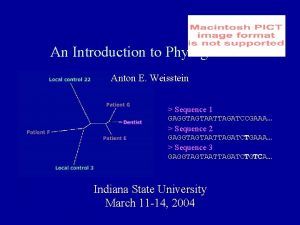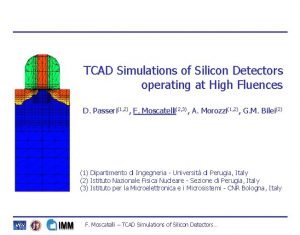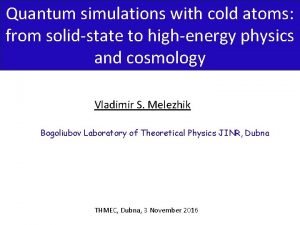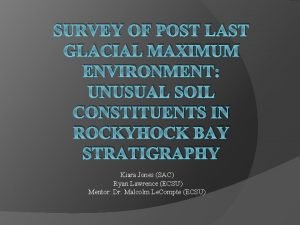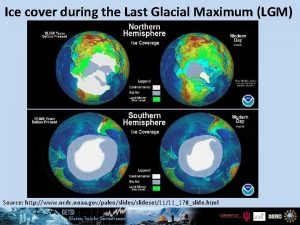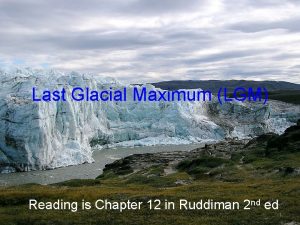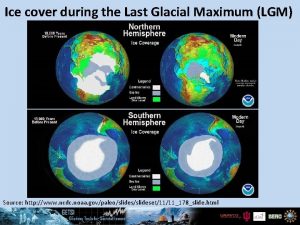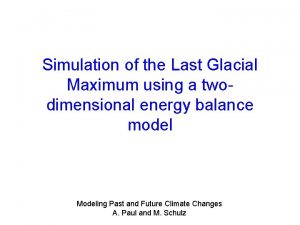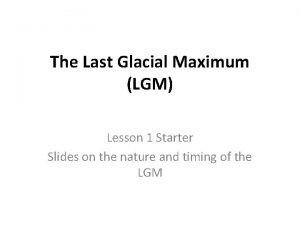High resolution simulations of Last Glacial Maximum climate











- Slides: 11

High resolution simulations of Last Glacial Maximum climate over Europe – a solution to discrepancies with observations? D. Lunt (1), A. Jost (2), P. Valdes (1), A. Abe-Ouchi(3) , M. Kageyama(2) , G. Ramstein, (2) (1) Bristol Research Initiative for the Dynamic Global Environment (BRIDGE), Bristol University, UK (2) LSCE, Gif-sur Yvette, France (3) CCSR, Tokyo University, Japan 1) Motivation 2) Experiment aims and description of models 3) Results – • LMDz, CCSR, Had. RM compared to observations • Discussion of results 4) Conclusions and future work d. j. lunt@bristol. ac. uk

MOTIVATION (previous work by Kageyama et al) Intercomparison of PMIP model results. No model simulated enough cooling over Europe at the LGM, compared to pollen data. Perhaps due to relatively low resolution (also, icesheet reconstruction, dust, vegetation changes).

EXPERIMENT AIMS + MODELS USED Does increasing the horizontal resolution of climate models improve the agreement with observations of Last Glacial Maximum temperature and precipitation? Use PMIP boundary conditions (CLIMAP SSTs, Peltier ICE 4 G ice sheets) LMDz low res present ØLMDz GCM • Low res 3. 75 ox 2. 5 o global • High res 1. 0 ox 0. 5 o (zoom centered on Paris (!) ) ØCCSR GCM LMDz high res present • Low res 6. 0 ox 5. 0 o global • High res 1. 0 ox 1. 0 o global ØHad. AM/Had. RM. • Low res 3. 75 ox 2. 5 o global. • High res 0. 45 ox 0. 45 o (regional model) LMDz low res LGM

RESULTS (1) - Tcold LMDz low res, Tcold (LGMpresent)

RESULTS (2) - Tcold CCSR, low res, Tcold, Had. AM, low res, Tcold, M=9. 0 M=8. 4 M’=11. 9 M’=10. 6 LMDz, low res, Tcold, M=6. 5 M’=9. 6

RESULTS (3) - Tcold Had. RM high res, Tcold (LGMpresent)

RESULTS (4) - Tcold CCSR, high res, Tcold, Had. RM, high res, Tcold, M’=12. 4 M’=5. 9 (cf 11. 9) (cf 10. 6) LMDz, high res, Tcold, M’=9. 8 (cf 9. 6)

DISCUSSION - Tcold ØHad. RM has the best simulation of Tcold. Why? ØVery cold sea-ice in North Atlantic. ØRegional model has good representation of structure and intensity of storms. More high-windspeed events – larger surface fluxes – greater cooling. Feedback due to increase in meridional temperature gradient with increasing sea-ice.

CCSR low res CCSR high res LMDz low res LMDz high res RESULTS (1) - Pann Mean absolute error CCSR LOW 270 HIGH 230 LMDz 240 260 Had 240 400 Had. AM low res Had. RM high res Reason for wetter LGM in Hadley Centre model: Relatively high CLIMAP SSTs In Mediterranean. Cold air above advected from sea-ice -900 mm +900 mm

CONCLUSIONS ØIn the Hadley Centre model, agreement with Tcold LGM data is much improved in the regional high res. model compared to standard global model. This is due to very cold sea-ice in North Atlantic, linked to high surface heat fluxes, linked to intense storm activity. Feedback is via increased meridional temperature gradient. ØIn the same model, precipitation worsens, possibly due to the CLIMAP Mediterranean SSTs, which may be too high. ØHowever, LMDz and CCSR do not show large differences between high and low resolutions. Maybe due to different approach, or ‘critical’ resolution. “The Last Glacial Maximum climate over Europe: High resolution simulations”, Jost, Lunt, Kageyama, Abe-Ouchi, Peyron, Valdes, and Ramstein, in prep.

FUTURE WORK ØInvestigate sea-ice issues further – inclusion of ‘leads’. ØValidation of sea-ice surface temperatures for the modern. ØNew interpretation of data – more modern analogues. ØInclusion of a small Alpine ice-cap. ØUpdated SST reconstructions.
 High resolution low resolution
High resolution low resolution Local minimum
Local minimum Maximum likelihood vs maximum parsimony
Maximum likelihood vs maximum parsimony Maximum likelihood vs maximum parsimony
Maximum likelihood vs maximum parsimony Climate change 2014 mitigation of climate change
Climate change 2014 mitigation of climate change Yes or no
Yes or no Clinical simulations in nursing education
Clinical simulations in nursing education Chris harding simulations
Chris harding simulations Tcad simulations
Tcad simulations World history simulations
World history simulations Simulations for solid state physics
Simulations for solid state physics Payroll card
Payroll card



